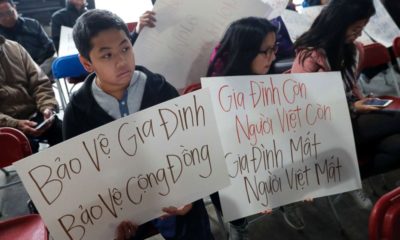Like Vietnam, China is a socialist country. The relationship between the two communist parties goes back to the 1920s when a young Ho Chi Minh worked alongside fellow revolutionary Zhou Enlai to mobilize peasants in southern China. Few political parties can boast of such a century-long international comradeship. Soon after Mao Zedong and Zhou took power in China, they supported the Vietnamese revolution by sending arms and advisors, helping Ho’s army win a decisive battle over the French at Dien Bien Phu in 1954.
During the Vietnam War, Beijing was Hanoi’s big brother as well as its most generous financier. Beijing sent Hanoi billions of dollars in cash, food and military aid even while millions of Chinese died of starvation. For much of the 1960s, more than 100,000 Chinese troops were stationed permanently in North Vietnam while PAVN soldiers were sent to fight in the south.
Relations turned dramatically as the war ended. Hanoi viewed Mao’s invitation for US President Richard Nixon to visit Beijing in 1972 as a despicably traitorous act. With both Beijing and Moscow courting Washington’s attention and with their victory over the Americans in 1975, Vietnamese leaders began to imagine themselves as vanguards of the world revolution. Their ambition to dominate Indochina riled Deng Xiaoping, who sent half a million troops across the border in 1979 to teach the “ungrateful” Vietnamese a lesson.
The border war between the communist brothers lasted until the late 1980s. As the Soviet bloc collapsed and the US-led camp emerged triumphantly, Hanoi felt threatened and quickly turned to Beijing, apologizing for the war and proposing a new anti-imperialist alliance. Although Beijing turned down the proposal, bilateral relations were restored in 1991.
To demonstrate a lesson had been learned, Hanoi leaders changed the constitution to remove anti-China passages. While Vietnam grandly celebrated the wars against France and the United States every year, the 1979 war with China was erased from public memory. State-controlled media were prohibited from publishing negative news about Chinese society, economy or politics, and editors who violated the ban were swiftly punished.
To attract much-needed foreign aid and investment once the Soviet bloc was no more, Hanoi sought to expand foreign relations, declaring that Vietnam welcomed friendship with all countries. However, an internal memo by the Politburo of the Vietnamese Communist Party showed that the party distinguished between “close and not so close friends” depending on their ideology. Vietnam restored relations with the United States in 1995 and concluded a bilateral agreement in 2001. As market reforms gathered steam, Vietnam achieved remarkable success with many exports including seafood, rice, and coffee. The United States became the leading market for Vietnamese exports, allowing the country to earn billions of dollars in trade surplus.Despite the value of the American market for Vietnam, the United States remained in the “not so close” category in the eyes of Hanoi leaders. Washington’s frequent criticism of Vietnam’s violations of human rights infuriated them, and US invasions of Afghanistan and Iraq prompted deep anxieties. As recently as 2005, PAVN still considered the United States a strategic enemy.
Across the border, bilateral relations between China and Vietnam thrived: Top leaders paid regular annual visits, as did representatives from the military, the Public Security Ministry, the Propaganda Department, the Communist Youth League, and various other government organs. No wonder that by 2011 China had overtaken the United States as Vietnam’s top trade partner. By 2014 its trade with China was nearly twice that with the United States. Ironically, Vietnam had a trade deficit with China as large as the trade surplus it enjoyed with the United States.
Problems began by 2005 when China began to aggressively enforce its sovereignty claims over much of the South China Sea, dashing Vietnamese leaders’ cherished hope that the comradely spirit between the two parties would soar above narrow national interests. While pursuing several strategies in response to China’s rising threat, Hanoi consistently assigned greater weight to talks between the two fraternal parties than to multilateral or legal approaches.
When China towed a giant oil rig within Vietnam’s exclusive economic zone in 2014, even as Hanoi sent Coast Guard ships to surround the Chinese naval force defending the rig, Party chief Nguyễn Phú Trọng tried to call Chinese President Xi Jinping a dozen times, hoping in vain that Xi would pick up the phone. On the streets, Vietnamese peacefully protesting against China was beaten, in some cases savagely, by security forces. Trọng later visited Washington, the first for a general secretary of the Vietnamese Communist Party.
After the oil rig confrontation, criticisms of China appeared in the Vietnamese press. Nevertheless, no sign exists that Hanoi has fundamentally changed its strategy in which timid overtures to the United States are made only when Beijing acts up. Given the domination of Marxist-Leninist loyalists in the top leadership elected at the 12th Party Congress in 2016, such change is less likely.
General Lịch’s welcome of a US aircraft carrier’s visit sends a signal of displeasure more than any drastic U-turn in Vietnamese policy regarding China. The Repsol affair left Hanoi with a bruised eye, and the country wants Beijing to know that it is unhappy. Still, like an abused spouse who calls the police after a beating but then refuses to end the relationship, Hanoi will follow its heart and is not about to break away from Beijing soon.

 Politics & Economy4 years ago
Politics & Economy4 years ago
 Politics & Economy2 years ago
Politics & Economy2 years ago
 After 19751 year ago
After 19751 year ago
 ARCHIVES5 years ago
ARCHIVES5 years ago
 Society & Culture5 years ago
Society & Culture5 years ago
 Politics & Economy4 years ago
Politics & Economy4 years ago
 Politics & Economy5 years ago
Politics & Economy5 years ago
 Vietnamese-America4 years ago
Vietnamese-America4 years ago








